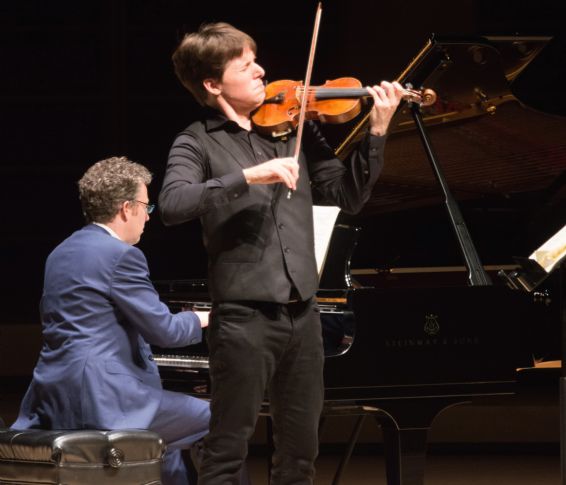|
Recital
ELEGANT VOCAL MASTERY AT ROSES SIGNATURE RECITAL
by Pamela Hicks Gailey
Sunday, February 25, 2024
Recital
DEMANDING SCHUMANN WORK IN MUSIC AT OAKMONT RECITAL
by Terry McNeill
Thursday, November 9, 2023
Recital
RARE RAVEL IN MENDO FESTIVAL'S PRESTON HALL
by Terry McNeill
Thursday, July 20, 2023
Recital
FRENCH FLAVOR IN RARE FOUR-HAND RECITAL
by Judy Walker
Sunday, January 15, 2023
Recital
ASSERTIVE PIANISM IN YAKUSHEV'S OCCIDENTAL RECITAL
by Terry McNeill
Sunday, November 13, 2022
Recital
HEROIC LIM PERFORMANCE AT STEINWAY SOCIETY RECITAL
by Abby Wasserman
Sunday, September 18, 2022
Recital
AGGRESSIVE PIANISM IN MYER'S MENDO FESTIVAL RECITAL
by Terry McNeill
Thursday, July 14, 2022
Recital
UNIQUE ELEGANCE IN GALBRAITH GUITAR RECITAL
by Gary Digman
Friday, April 29, 2022
Recital
ALLURING GLASS WORKS IN WEILL RECITAL
by Terry McNeill
Friday, March 25, 2022
Recital
FORGOTTEN BACH SHINES IN YARDEN'S OAKMONT RECITAL
by Terry McNeill
Thursday, March 10, 2022
|
 |
 Sam Haywood and Joshua Bell Playing Faure in Weill Hall (K. Loken Photo) |
ENCHANTMENT, REVOLUTION AND NOSTALGIA IN BELL'S WEILL HALL RECITAL
by Sonia Morse Tubridy and Nicki Bell
Saturday, October 17, 2015
Violinist Joshua Bell and pianist Sam Haywood played a dazzling concert of sonatas and duos Oct. 17 to a joyfully rapt audience of 1,000 in Weill Hall, and the program showcased two popular A Major sonatas for violin and piano, Beethoven's Op. 47 (“Kreutzer”), and Faure's No. 1, Op. 13.
These were preceded by the Vitali’s Chaconne in G minor, a Baroque virtuoso piece that might be an example of a 19th century hoax. The work gave Mr. Bell dozens of flights of technical and musical virtuosity, and the artist’s extraordinary warm and captivating tone filled the hall in every dynamic range. He exhibited a wonderful range of mastery, moving with ease from delicate to powerful, limpid to muscular, achingly yearning to noble and proud. Rubatos were plentiful and phrases shaped with impetuous urgency or lingering tenderness. The palate of sound colors was ready for the evening ahead. Bell played the Chaconne by memory and was supported beautifully by Mr. Haywood. The audience gave them a standing ovation.
The artists moved directly to the famous Kreutzer, a watershed composition in Beethoven's life and in the history of violin music. The new monumental sounds of symphonies, operas and oratorios are here given to the small ensemble of violin/piano and the sonata is no longer a salon entertainment, but a revolutionary musical statement. The first movement opens with a solo violin statement which was played with soft intimate expression and then becomes a dialogue with the piano, trading a half step motive back and forth. The stillness of the Adagio sostenuto then gives way to an intense and furious Presto with outbursts of demonic musical utterances occasionally interrupted by chorale-like lyrical moments. The tempo was extreme, almost carrying the passagework beyond audibility of detail and constantly striving for heroic large statements demanding our attention. The audience burst into applause at the end of the final chord.
The second movement is a classical theme and variations providing calm after the storm. The opening theme was played with simplicity and sweetness allowing the variations to grow out of it into expressions of playfulness, lyricism, humor, mystery and joy. Mr. Bell, dressed in a chic black outfit, was constantly in dancelike motion giving a visual expression to the music. Phrase synchronization of both musicians was lovely to hear. The final movement (presto) is a sparkling romp of a tarantella, a racing gallop with Mr. Bell crouching and springing as the mad horseman rushing forward with phenomenal speed. His pianist provided the support and stability for the impetuosity of the violin. At the final chord the audience leaped up for another standing ovation.
After a short intermission Faure's restless and Schumannesque work from 1876 was played. Mr. Haywood's pianism was exquisite with fluid and flexible lines shining through cascades of notes which gave the long singing lines of the violin deep currents on which to float and sparkle. This sonata helped lead the way from the 19th century to the 20th, not by urgent cries as Beethoven's “Kreutzer” had ushered music forward, but by enchantment. Faure's teacher and friend, Saint-Saëns wrote "In this sonata you can find everything to tempt a gourmet: new forms, excellent modulations, unusual tone colors, and the use of unexpected rhythms. And a magic floats above everything, encompassing the whole work, causing the crowd of usual listeners to accept the unimagined audacity as something quite normal. With this work Monsieur Faure takes his place among the masters."
The second movement, a gentle dreamy violin over a steady barcarolle beat, rises from darkness into ecstatic light. The lively scherzo evoked scherzos by Mendelssohn or Brahms, little magical beings scampering and fluttering almost outside our perceptions, contrasting with a lyrical legato trio. This scherzo brought a communal audience chuckle at the end. The magic of this piece had united audience and performers. The finale brought back the cascades of sparkling piano notes with the violin again expressive and lyrical in a relaxed rondo form. Once again the audience rose for a standing ovation.
The last part was a change from the printed version. Speaking from the stage, Mr Bell said that this concert was intended as a tribute to Josef Gingold, his principle teacher. The works played were ones that had been studied with Gingold, and the Faure was one of the teacher's favorites.
The violinist praised the Weill Hall and proceeded to play violin crowd pleasers, some of which he hadn't performed in 20 years: Brahms' Hungarian Dance No. 1, Fritz Kreisler's Liebesleid and Wieniawski's Scherzo Tarantelle. Audience members seemed to relish these treats and the tribute to Mr. Bell's teacher. And finally, the audience went crazy with appreciation, shouting, whistling, bringing the performers back to the stage four times.
|

